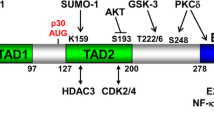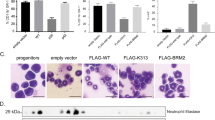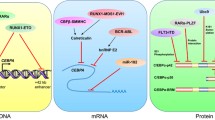Abstract
Heterozygous mutations of the CEBPA gene are present in 5% of acute myeloid leukemia (AML) cases and often lead to the expression of an N-terminally truncated, 30 kDa isoform, C/EBPαp30, from an internal translation start site. We have assessed the effect of C/EBPαp30 on granulopoiesis utilizing C/EBPαp30-ER, containing the estradiol receptor ligand-binding domain. In contrast to C/EBPα-ER, C/EBPαp30-ER did not induce 32Dcl3 myeloid cell differentiation in IL-3. However, both isoforms, when expressed at high levels, were capable of inhibiting E2F activity in 32Dcl3 cells and of slowing their G1 to S progression. C/EBPαp30 repressed expression of the endogenous G-CSF receptor several-fold. To facilitate investigation of the effect of C/EBPαp30-ER on granulopoiesis downstream of G-CSF signalling, we coexpressed exogenous G-CSF receptor. C/EBPαp30-ER/GR cells expressed several granulocytic markers in G-CSF and demonstrated nuclear maturation. Rat C/EBPα-ER and C/EBPαp30-ER, expressed in 293T cells, bound the C/EBP site from the NE gene with similar affinity, as did human C/EBPα and C/EBPαp30. In contrast, C/EBPαp30 bound the C/EBP sites in the PU.1 or GR gene with 3–6-fold reduced affinity. Thus, the selective inhibition of GR expression by C/EBPαp30-ER is due in part to its variable affinity for C/EBP sites. Variation in affinity for selected cis elements among isoforms may affect the biology of basic region-leucine zipper (bZIP) proteins.







Similar content being viewed by others
References
An MR, Hsieh CC, Reisner PD, Rabek JP, Scott SG, Kuninger DT and Papaconstantinou J . (1996). Mol. Cell. Biol., 16, 2295–2306.
Birkenmeier EH, Gwyenn B, Howard S, Jerry J, Gordon JI, Landschulz WH and McKnight SL . (1989). Genes Dev., 3, 1146–1156.
Britos-Bray M, Ramirez M, Cao W, Wang X, Liu PP, Civin CI and Friedman AD . (1998). Blood, 92, 4344–4352.
Calkhoven CF, Muller C and Leutz A . (2000). Genes Dev., 14, 1920–1932.
Christy RJ, Yang VW, Ntambi JM, Geiman DE, Landschulz WH, Friedman AD, Nakabeppu Y, Kelly TJ and Lane MD . (1989). Genes Dev., 3, 1323–1335.
Descombes P and Schibler U . (1991). Cell, 67, 569–579.
Diehl AM, Michaelson P and Yang SQ . (1994). Gastroenterology, 106, 1625–1637.
Friedman AD . (1996). Cancer Res., 56, 3250–3256.
Friedman AD . (2002a). Oncogene, 21, 3377–3390.
Friedman AD . (2002b). J. Cell. Biochem., 86, 624–629.
Friedman AD, Landschulz WH and McKnight SL . (1989). Genes Dev., 3, 1314–1322.
Friedman AD and McKnight SL . (1990). Genes Dev., 4, 1416–1426.
Gombart AF, Hofmann WK, Kawano S, Takeuchi S, Krug U, Kwok SH, Larsen RJ, Asou H, Miller CW, Hoelzer D and Koeffler HP . (2002). Blood, 99, 1332–1340.
Iwasaki-Arai J, Zhang P, Huettner CS, Fenyus M, Lekstrom-Himes J, Tenen DG and Akashi K . (2002). Blood, 100, 61a.
Johansen LM, D'Alo' F, Nelson EA, Radomska HS, Evans EK, Zhang P, Nerlov C and Tenen DG . (2003). Blood, in press.
Keeshan K, Santill G, Corradini F, Perrotti D and Clabretta B . (2003). Blood, 102, 1267–1275.
Kummalue T and Friedman AD . (2003). J. Leuk. Biol., 72, 464–470.
Landschulz WH, Johnson PF and McKnight SL . (1989). Science, 246, 1681–1688.
Lin FT, MacDougland OA, Diehl AM and Lane MD . (1993). Proc. Natl. Acad. Sci. USA, 90, 9606–9610.
Liu H, Keefer JR, Wang Q and Friedman AD . (2003). Blood, 101, 3885–3892.
Lou J, Cao W, Bernardin F, Ayyanathan K, Rauscher III FJ and Friedman AD . (2000). Oncogene, 19, 2695–2703.
Nuchprayoon I, Meyers S, Scott LM, Suzow J, Hiebert S and Friedman AD . (1994). Mol. Cell. Biol., 14, 5558–5568.
Oelgeschläger M, Nuchprayoon I, Luscher B and Friedman AD . (1996). Mol. Cell. Biol., 16, 4717–4725.
Pabst T, Mueller BU, Zhang P, Radomska HS, Narravula S, Schnittger S, Behre G, Hiddemann W and Tenen DG . (2001). Nat. Genet., 27, 263–270.
Porse BT, Pedersen TA, Xu X, Lindberg B, Wewer UM, Friis-Hansen L and Nerlov C . (2001). Cell, 107, 247–258.
Radomska HS, Huettner CS, Zhang P and Tenen DG . (1998). Mol. Cell. Biol., 18, 4301–4314.
Rangatia J, Vangala RK, Treiber N, Zhang P, Radomska H, Tenen DG, Hiddemann W and Behre G . (2002). Mol. Cell. Biol., 22, 8681–8694.
Raught B, Liao WS and Rosen JM . (1995). Mol. Endocrinol., 9, 1223–1232.
Reddy VA, Iwama A, Iotzova G, Schulz M, Elsasser A, Vangala RK, Tenen DG, Hiddemann W and Behre G . (2002). Blood, 100, 483–490.
Scott LM, Civin CI, Rorth P and Friedman AD . (1992). Blood, 80, 1725–1735.
Smith LT, Hohaus S, Gonzalez DA, Dziennis SE and Tenen DG . (1996). Blood, 88, 1234–1247.
Suzow JG and Friedman AD . (1993). Mol. Cell. Biol., 13, 2141–2151.
Theilgaard-Moench K, Ungermand C, Damgaard I, Rasmussen T, Verbeek W, Jacobsen SE, Borregaard N and Porse B . (2002). Blood, 100, 298a.
Umek RM, Friedman AD and McKnight SL . (1991). Science, 251, 288–292.
Valtieri M, Tweardy DJ, Caracciolo D, Johnson K, Mavilio F, Altmann S, Santoli D and Rovera G . (1987). J. Immunol., 138, 3829–3835.
Wang H, Iakova P, Wilde M, Welm A, Goode T, Roesler WJ and Timchenko NA . (2001a). Mol. Cell, 8, 817–828.
Wang X, Scott E, Sawyers CL and Friedman AD . (1999). Blood, 94, 560–571.
Wang W, Wang X, Ward A, Touw I and Friedman AD . (2001b). Leukemia, 15, 779–786.
Wang QF, Cleaves R, Kummalue T, Nerlov C and Friedman AD . (2003). Oncogene, 22, 2548–2557.
Wang QF and Friedman AD . (2002). Blood, 99, 2776–2785.
Yen J, Wisdom RM, Tratner I and Verma I . (1991). Proc. Natl. Acad. Sci. USA, 88, 5077–5081.
Zhang DE, Zhang P, Wang ND, Hetherington CJ, Darlington GJ and Tenen DG . (1997). Proc. Natl. Acad. Sci. USA, 94, 569–574.
Zhang P, Iwama A, Datta MW, Darlington GJ, Link DC and Tenen DG . (1998). J. Exp. Med., 188, 1173–1184.
Acknowledgements
We thank D Tenen, B Porse, and C Nerlov for plasmids and C Stocking for her comparison of rat, mouse, and human C/EBPα sequences. This work was supported by NIH Grant R01 HL51388. ADF is also supported by the Children's Cancer Foundation and is a Scholar of the Leukemia & Lymphoma Society.
Author information
Authors and Affiliations
Corresponding author
Rights and permissions
About this article
Cite this article
Cleaves, R., Wang, Qf. & Friedman, A. C/EBPαp30, a myeloid leukemia oncoprotein, limits G-CSF receptor expression but not terminal granulopoiesis via site-selective inhibition of C/EBP DNA binding. Oncogene 23, 716–725 (2004). https://doi.org/10.1038/sj.onc.1207172
Received:
Revised:
Accepted:
Published:
Issue Date:
DOI: https://doi.org/10.1038/sj.onc.1207172
- Springer Nature Limited
Keywords
This article is cited by
-
Homodimer-mediated phosphorylation of C/EBPα-p42 S16 modulates acute myeloid leukaemia differentiation through liquid-liquid phase separation
Nature Communications (2023)
-
The splicing factor RBM25 controls MYC activity in acute myeloid leukemia
Nature Communications (2019)
-
C/EBPα in normal and malignant myelopoiesis
International Journal of Hematology (2015)
-
Pharmacological targeting of the Wdr5-MLL interaction in C/EBPα N-terminal leukemia
Nature Chemical Biology (2015)
-
Expression of different functional isoforms in haematopoiesis
International Journal of Hematology (2014)




